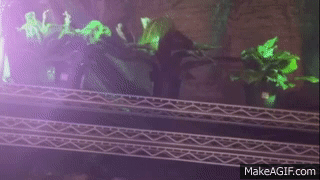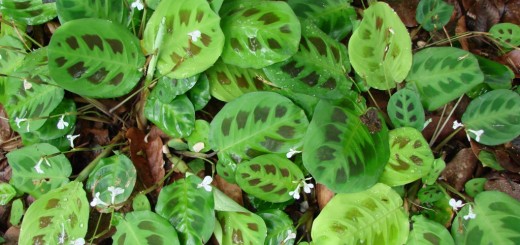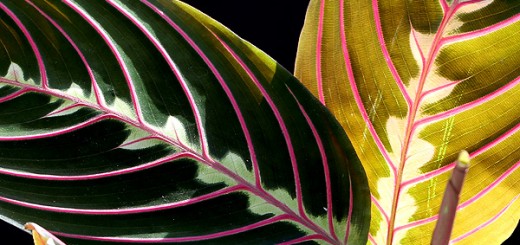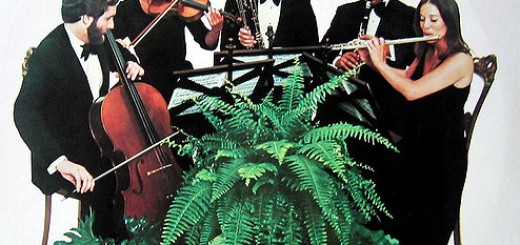Exploring Sound and Circadian Rhythm

Research Project By Lovina Muña, Forest Davis, Pierson Roe, Anthony Lopez, and Emilia Vidal-Hallett
Project Summary
We will be looking at the differences in the nyctinastic movement of three Maranta leuconeura plants. Starting off with plant listening to no music and then being subjected to a song played on loop over the span of 4 days. After observing the circadian rhythms in silence for a four day period, we will begin playing the music and observe the effects of the sound four
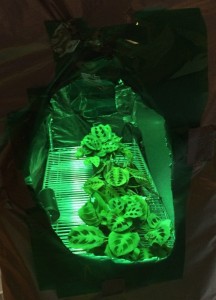
View of the Prayer Plants Through Green Filter. (EVH, 2016)
days later. The plants will be subjected to the music of the death metal band Cryptopsy and their song “Abigor”. The song will be played nonstop throughout the duration of the experiment, at a constant volume. We will film and create a time-lapse of 24 hours of movement for each of the groups and then use video analysis to determine the results. In our video analysis, we will determine the angle changes of the leaves throughout one 24 hour cycle. .
Intro/Background:
Circadian rhythms are 24 hour cycles that affect the mental, physical and behavioral changes in plants and animals. The circadian rhythm we will be observing is the opening and closing of M. leuconeura leaves. The opening and closing of the leaves for night is called nyctinastic movement, which means sleep movements. You can read all about nyctinastic movements in detail at the link provided, but essentially it’s the plant responding to the light and dark cycle of a day and the leaves moving up and down in response. It isn’t exactly understood why this occurs, but one possible reason could be for protection while the plant isn’t absorbing light during the day. We chose M. leuconeura because it’s nyctinastic movements are easy to see, they were easily obtainable, and one of our group members had experience in raising these prayer plants before.
We initially looked at using sound because there has been proof in the past of sound positively affecting plant growth in plants, such as strawberries (Qi L, Teng G, Hou T, etc. 2010). If sound can affect growth, then perhaps it can affect circadian rhythms and nyctinastic movement as well? Well, looking further into circadian rhythms we learned that they are governed by a specific photoreceptor called a cryptochrome, which picks up blue light. What this means is that the sole dictator over these day/night cycles is a specific wavelength of light alone. However, we were still interested in if sound, and wanted to carry on our experiment, if no reason other than to prove sound will have no effect on the nyctinasty of M. leuconeura.
For both groups of plants, we expect to have typical measurements of the plant’s circadian rhythms. This is because circadian rhythms are dictated by blue light, which is absorbed by cryptochromes (see above). If the only factor controlling circadian rhythms is what wavelengths of light the plant is receiving, then external stimulus such as sound, while maybe affecting other parts of the plant’s biology (e.g. growth), won’t have an effect on the plants circadian rhythms, including our measured nyctinastic movement.
Procedure:
We will begin with our group of three M. leuconeura plants. For our control group, we will have no music playing. After 4 days, we will start our time lapse recording for the last 24 hours of each four day period, in order to have a more manageable data-set in terms of the number of pictures and time frame. We will have lamps on 13 hour cycles of light, to 11 hours of darkness (8:00 AM to 9:00 PM exposed to the light), in order to control the amount of light for each plant. In order to capture footage when the overhead lights are off, we covered holes on the sides of where we are keeping our plants with green filter paper. Because circadian rhythms are controlled by blue, light, we can use green light in order to illuminate the plants to take footage without disrupting the plants natural cycles. There will be a time-lapse of the groups and then we can analyse the video to determine the results. In our video analysis we will look at angle changes of the leaves throughout time.
Results:
We had expected that the sound would have no effect on the nyctinastic movement of M. leuconeura‘s circadian rhythm, as stated above.
Control Group
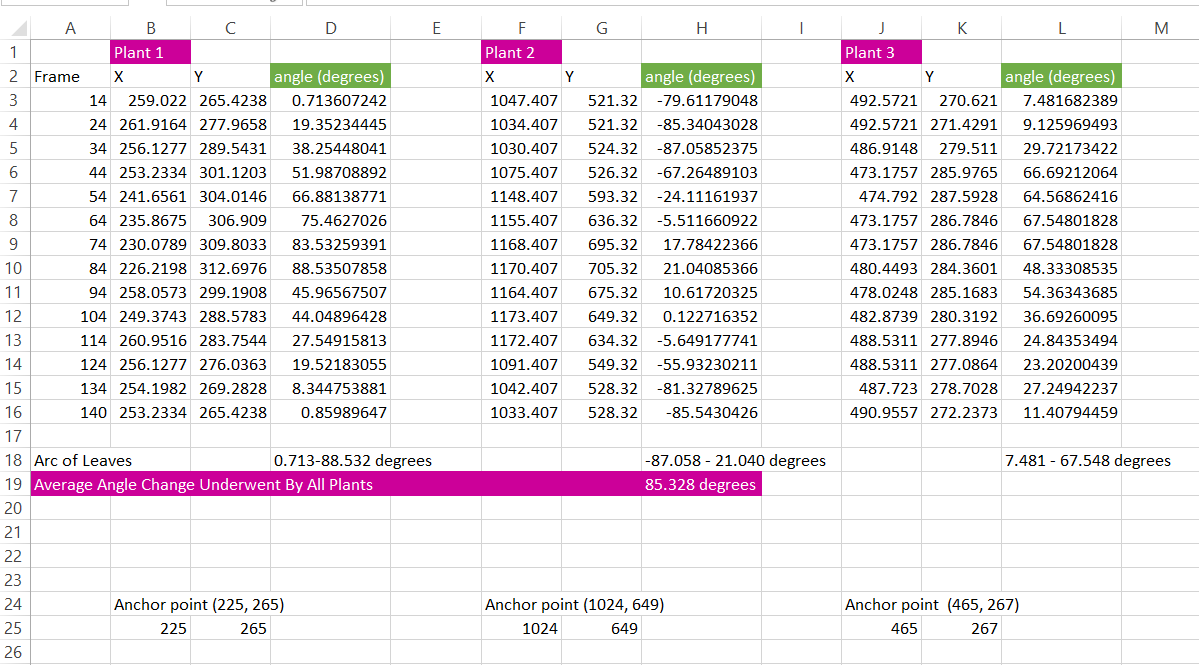
In the above figure, you can see the change in angle over time, as well as overall arc of the leaves, and then average angle change for the control group of plants. The X and Y columns are just the position of the tip of the leaves on the screen in a coordinate pair every 10 frames of our time lapse. The anchor point listed below is the point where the leaf pivots upwards. Looking at only one leaf on each of the three plants and then averaging the angle changes shows us that on average, the leaf will move through an 85.328 degree angle arc in one days cycle of nyctinastic movement. This is in line with the paper from Norman D. Hill, which says it moves through an arc of about 90 degrees.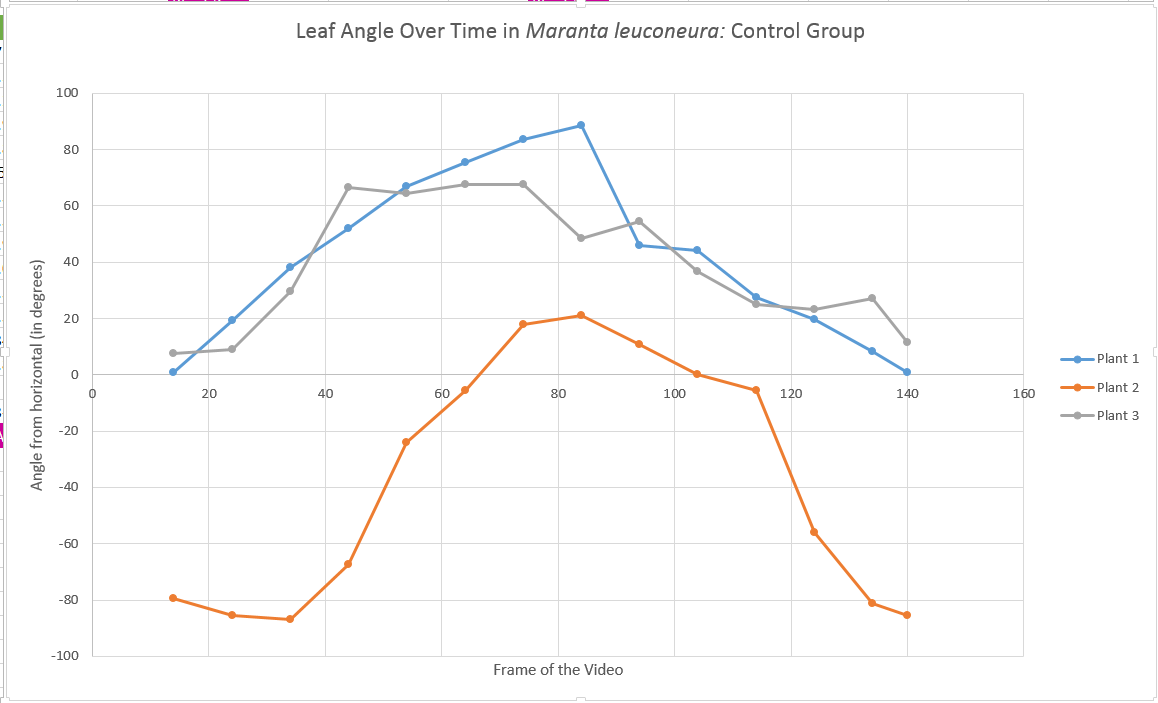
This graph shows the change in angle from horizontal for each of the plants as frames advance. The X axis represents what frame of the video we took that particular data point, and the Y axis represents the angle in degrees at that point. The 0 on the Y represents the horizontal, and so negative numbers are for when the leaf droops below flat. As you can see, each plant shows the same general trend of increasing the angle and moving the leaves upwards over time, before decreasing again as the leaves move back down.
Experimental Group
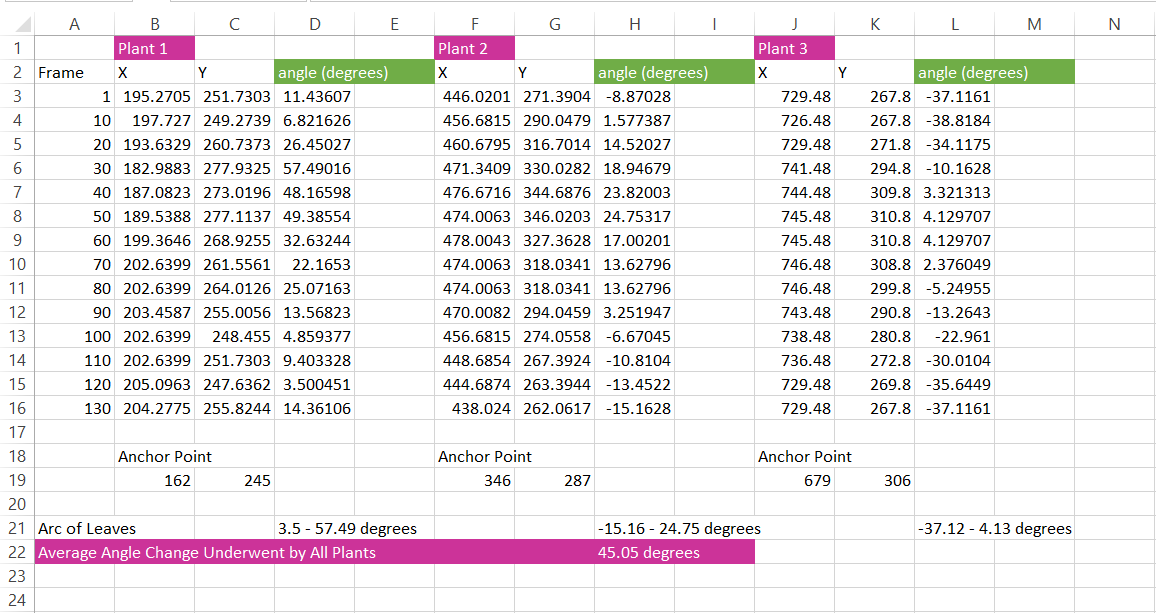
This figure is laid out in the same way as the above one, therefore see the first paragraph under the “Control Group” sub-heading for how to view this table. From one leaf per plant, and averaging together their movements, the average angle change our plants went through during one day’s cycle is 45.05 degrees.
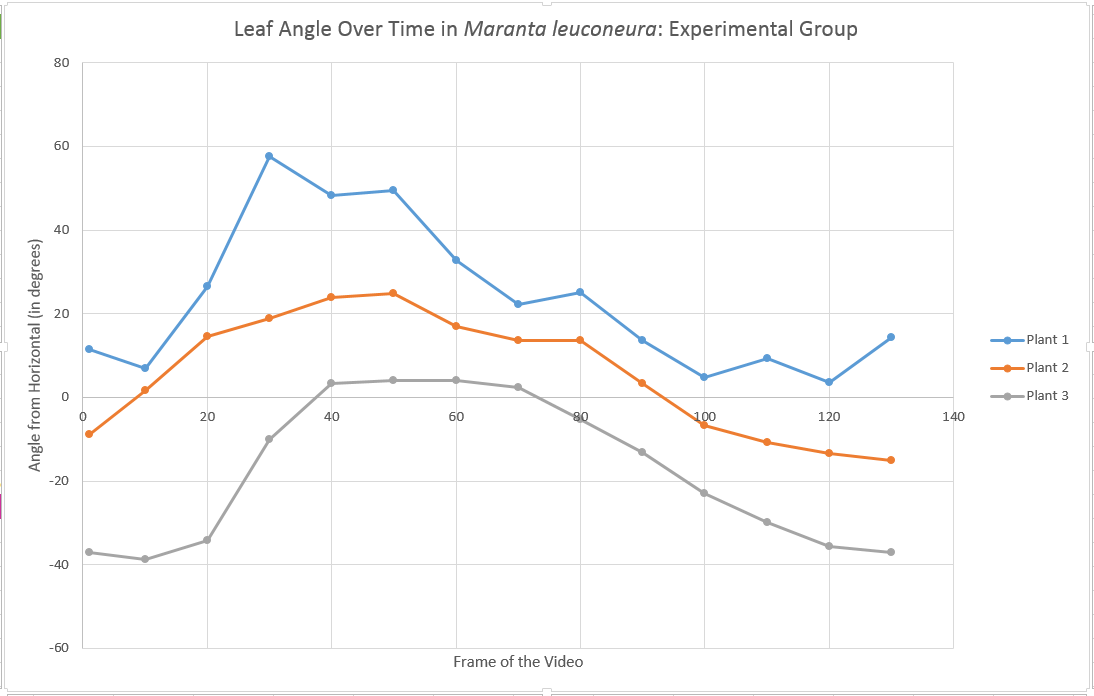
The graph is laid out the same way as above as well. Just like the control group, you can see that the overall trend for angle change in the leaves for all three plants follows the trend of the leaves moving upwards and then back down again.
What does this mean?: Based off the evidence seen in the tables and graphs, we can draw the conclusion that the presence of music, in the form of “Abigor” by Cryptopsy, decreased the overall nyctinastic movement that takes place during M. leuconeura‘s circadian rhythm. A possibility could be that the constant sound coming from the speaker “tricked” the plant into thinking that it had not fully become night time yet, since noise level usually goes down the later it gets. Another possible explanation is that the sound waves somehow interfered with the cryptochromes ability to properly perform nyctinastic movements. Again, both of these explanations are only possibilities and our group is not claiming them to be true.
Error Analysis: We understand that there is a lot of room for error in this experiment. The amount of water on the plants was irregular, we played the music at a volume that sounded fine but wasn’t directly measured, at one point the music kept turning off after a few hours so we had to keep trying different solutions, and the lamps with the green light through the sides were only used during the 24 hour recording processes, as well as potentially many more conditions out of our control. During the analysis, due to lighting and camera issues, it wasn’t possible to analyze the same leaf in both videos, therefore while we did take the average for the three plants, those leaves in particular might have just not showed as much movement in general. In the overall video for our experimental group of plants, it generally seemed as though the movement was similar to the control group, but our results for those particular leaves didn’t show it. This isn’t to say our data is entirely invalid, just that there are mistakes to keep in mind.
In order to produce more accurate data, we could have done the analysis with at least 3-5 leaves per plant, and then average those, and average the results from all 3 plants as well. We also could have done longer trial periods, and repeated the tests as well, but due to numerous technical difficulties, time was our enemy and we couldn’t perform the trials that we wanted.
References:
Appel H. M, Cocroft R.B. Plants respond to leaf vibrations caused by insect herbivore chewing. Oceologia. Vol. 175, Iss. 4. 2014 [cited 2016 Apr 28] Available from http://link.springer.com/article/10.1007/S00442-014-2995-6
Hill N. Sleep Movements of the Prayer Plant Maranta leuconeura Morren. Bios. Beta Beta Beta Biological Society. Vol. 31, No. 3. 1960 [cited 2016 Apr 28]. Available from http://www.jstor.org/stable/4606210?seq=3#page_scan_tab_contents
Qi L, Teng G, Hou T, Zhu B, Liu X. Influence of sound wave stimulation on the growth of strawberry in sunlight greenhouse. Computer and computing technologies in agriculture III. IFIP advances in information and communication technology, vol 317. 2010 [cited 2016 Apr 28]. Available from http://link.springer.com/chapter/10.1007/978-3-642-12220-0_65
Ray F. Evert, Susan E. Eichhorn. 2013. Biology of Plants. New York: W. H. Freeman and Company Pg. 665-670. Text. [cited 2016 April 21]
